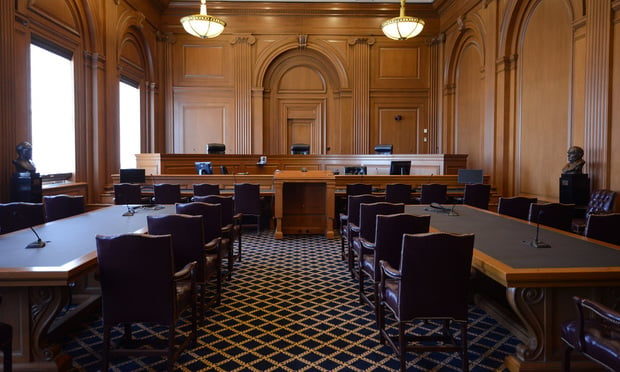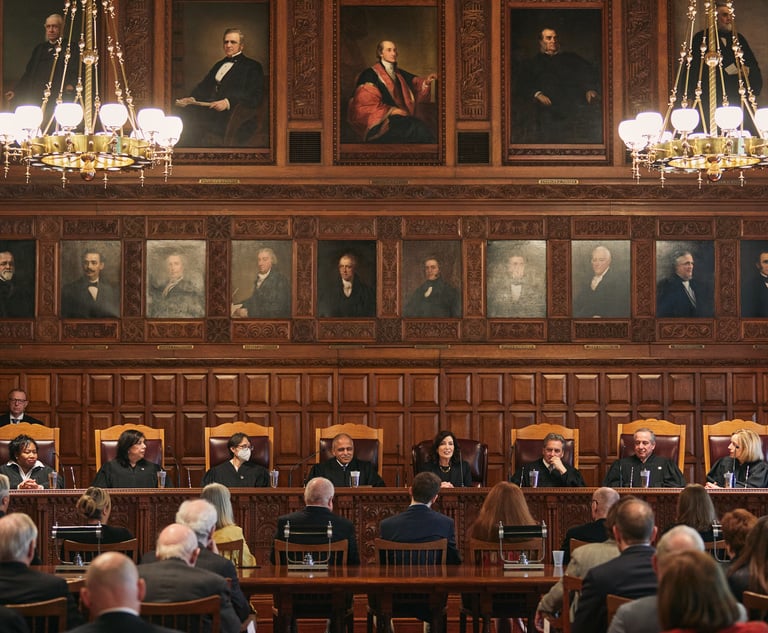There's No Substitute for a Real Live Court Reporter
A trained court reporter (not court recorder) can produce a realtime verbatim transcript of proceedings with 99% accuracy. That is in realtime, instantaneously, immediately, as the proceedings are occurring.
August 12, 2019 at 11:00 AM
7 minute read
 A Second Circuit courtroom at the Thurgood Marshall Courthouse, 40 Foley Square. Photo: Rick Kopstein/NYLJ
A Second Circuit courtroom at the Thurgood Marshall Courthouse, 40 Foley Square. Photo: Rick Kopstein/NYLJ
I am a very proud court reporter. I’ve been so for almost 31 years. Not only am I a court reporter, but I am also the president of the Supreme Court Reporters Association Within The City of New York. I will tell you that right up front, as opposed to the shrouded authors of so many digital recording articles who are naysayers and grey-sky portrait painters as regards the field of court reporting.
When I read about artificial intelligence being used out there, digital recordings of proceedings, it is just so fulfilling when I then read about how the attorneys hate it, cannot rely on it, are telling their agencies “Do not send a recorder! Send a real, live, breathing, skilled court reporter!” It makes me smile because we have known it all along and the bench and bar have known it all along: Court reporters are the gold standard of creating a record.
Does the field of court reporting/court stenography need more reporters? We sure do. Is there market turmoil as mentioned in the article? No, there is not turmoil. Words like “turmoil,” “rapid decline” in the number of active court reporters are being espoused by special interest “authors” who produce articles for the legal field to change the way of thinking of potential clients; to garner business.
To garner business for who, you may ask. For the companies in which these authors have a financial interest. Such is the case with so many articles crying out about a shortage of court reporters and how artificial intelligence is the better, more technologically advanced method to use. Well, the New York Law Journal Commentary article by Steve Townsend is yet another example of misleading information.
Mr. Townsend is the CEO of The Record X-Change, a legal proceedings recording company. One could suppose a company such as The Record X-Change sees a court reporter as the competition. The American Association of Electronic Reporters and Transcribers (AAERT), who Mr. Townsend’s article mentions as being formed because they “recognized the need to support electronic court reporting by establishing best practices and certification programs” finds itself in the same boat as The Record X-Change. It sees court reporters as the competition.
What do these companies do to try to defeat their competition? Make general comparisons where they look like a winner, they slant data, exaggerate their products, or just outright unfairly slant in the light most favorable to them. Sort of reminds me of the Chick-fil-A billboard advertisements where cows are imploring you to “EAT MOR CHIKIN” so they can flourish.
Let us look at a statement from Mr. Townsend’s commentary, wherein he talks about an in-depth study conducted in 1983 on the use of audio recording (tapes) to capture the official record of court proceedings in U.S. district courts. According to his article, the study concluded that:
“Given appropriate management and supervision, electronic sound recording can provide an accurate record of United States district court proceedings at reduced costs, without delay or interruption and provide the basis for accurate and timely, transcript delivery.”
The article then goes on to state that since the 1983 study, recording technology has advanced dramatically. I’m sure it has. Let’s talk about the technological capabilities of a court reporter and correct the misconceived notion that we are antiquated.
A trained court reporter (not court recorder) can produce a realtime verbatim transcript of proceedings with 99% accuracy. That is in realtime, instantaneously, immediately, as the proceedings are occurring. I think you get the picture. When providing realtime services, a court reporter streams their recordation of the proceedings directly to a user’s laptop, desktop, iPad, tablet or smartphone. Artificial intelligence, while useful in many applications, just cannot stand up to the output a realtime reporter can produce.
Talk into your smartphone, Alexa or some other voice-to-text application in normal, conversational cadence and see how frustrating it can be. Now do that at speeds of up to 225 words per minute and see how disastrous it can be. Throw in some technical jargon, be it medical, industrial, etc. and the transcript would not be useful if voice recognition is used. The best thing we could have done, and are doing, is not fight technology, but advance with it. We can be sitting in a courtroom or a deposition room here in New York City and be remotely sending our realtime feed to an expert witness in Hong Kong. The field has changed and we have made the adjustments.
Before leaving school, a court reporting student must be able to write 225 words per minute. Additionally, a court reporter is present in the room and can clarify any discrepancies, inaudible words, phrases and adds priceless human interaction with the attorneys, witnesses, judges; whoever is part of the record.
I’d like to harken back to the U.S. district court study. In federal court proceedings in New York, a live court reporter (not court recorder) is used. In New York federal court, a recording is only used for civil matters such as during an initial pretrial conference where the record is not of utmost importance. However, there are judges who require a court reporter for those hearings in lieu of a recording device. Arraignments by a federal judge, as opposed to a magistrate judge, are always taken by a live court reporter. In fact, all criminal proceedings before a federal judge are taken by a court reporter.
In magistrate court, a recording is sometimes used for initial presentments or arraignments, but court reporters are used for felony pleas due to the importance of the accuracy of the record.
Court reporting has long been an intriguing but little-known profession, but the bolstering of the number of court reporters has begun. State associations are becoming more involved in recruitment, in educating the public on the field, in educating reporters. Newscasts have been televised nationwide describing the field, its long history and the many areas of today’s social and business world where court reporting is now used. New court reporting programs are starting in various parts of the country. Things are progressing in terms of the numbers challenge. We are at a renaissance time period for court reporting. The public at large is being educated about the field, on just what we do, how technologically advanced we have become and what employment opportunities are available.
Let me touch on the employment aspect. I want to let you know something that was shared with me from The New York State Office of Court Administration. And this is a quote. This went out nationwide; not just in New York.
“I am requesting that you post notification to your court reporter students that there is, and will continue to be, a place for court reporters in the New York State Unified Court System. Following graduation with a certificate and a minimum of six months experience, the graduate is eligible to sit for the NYS Civil Service Exam for the title of court reporter.
Upon passing the exam and obtaining one year of court reporting experience they are eligible for appointment to a permanent position from the many and various employment opportunities available as an official court reporter for the New York State Unified Court System.
“New York State has made a commitment to continue to seek and employ court reporters, utilizing all the great services, such as realtime, CART, and paperless technology that only a court reporter can provide. A long and wonderful career awaits the court reporter graduate in New York State.”
That is a promulgation by the New York State Court System. They are aware of the gold standard.
Eric Allen is the president of the Association of Supreme Court Reporters.
.
This content has been archived. It is available through our partners, LexisNexis® and Bloomberg Law.
To view this content, please continue to their sites.
Not a Lexis Subscriber?
Subscribe Now
Not a Bloomberg Law Subscriber?
Subscribe Now
NOT FOR REPRINT
© 2025 ALM Global, LLC, All Rights Reserved. Request academic re-use from www.copyright.com. All other uses, submit a request to [email protected]. For more information visit Asset & Logo Licensing.
You Might Like
View AllTrending Stories
- 16-48. It’s Comp Time Again: How To Crush Your Comp Memo
- 2'Religious Discrimination'?: 4th Circuit Revives Challenge to Employer Vaccine Mandate
- 3Fight Over Amicus-Funding Disclosure Surfaces in Google Play Appeal
- 4The Power of Student Prior Knowledge in Legal Education
- 5Chicago Cubs' IP Claim to Continue Against Wrigley View Rooftop, Judge Rules
Who Got The Work
Michael G. Bongiorno, Andrew Scott Dulberg and Elizabeth E. Driscoll from Wilmer Cutler Pickering Hale and Dorr have stepped in to represent Symbotic Inc., an A.I.-enabled technology platform that focuses on increasing supply chain efficiency, and other defendants in a pending shareholder derivative lawsuit. The case, filed Oct. 2 in Massachusetts District Court by the Brown Law Firm on behalf of Stephen Austen, accuses certain officers and directors of misleading investors in regard to Symbotic's potential for margin growth by failing to disclose that the company was not equipped to timely deploy its systems or manage expenses through project delays. The case, assigned to U.S. District Judge Nathaniel M. Gorton, is 1:24-cv-12522, Austen v. Cohen et al.
Who Got The Work
Edmund Polubinski and Marie Killmond of Davis Polk & Wardwell have entered appearances for data platform software development company MongoDB and other defendants in a pending shareholder derivative lawsuit. The action, filed Oct. 7 in New York Southern District Court by the Brown Law Firm, accuses the company's directors and/or officers of falsely expressing confidence in the company’s restructuring of its sales incentive plan and downplaying the severity of decreases in its upfront commitments. The case is 1:24-cv-07594, Roy v. Ittycheria et al.
Who Got The Work
Amy O. Bruchs and Kurt F. Ellison of Michael Best & Friedrich have entered appearances for Epic Systems Corp. in a pending employment discrimination lawsuit. The suit was filed Sept. 7 in Wisconsin Western District Court by Levine Eisberner LLC and Siri & Glimstad on behalf of a project manager who claims that he was wrongfully terminated after applying for a religious exemption to the defendant's COVID-19 vaccine mandate. The case, assigned to U.S. Magistrate Judge Anita Marie Boor, is 3:24-cv-00630, Secker, Nathan v. Epic Systems Corporation.
Who Got The Work
David X. Sullivan, Thomas J. Finn and Gregory A. Hall from McCarter & English have entered appearances for Sunrun Installation Services in a pending civil rights lawsuit. The complaint was filed Sept. 4 in Connecticut District Court by attorney Robert M. Berke on behalf of former employee George Edward Steins, who was arrested and charged with employing an unregistered home improvement salesperson. The complaint alleges that had Sunrun informed the Connecticut Department of Consumer Protection that the plaintiff's employment had ended in 2017 and that he no longer held Sunrun's home improvement contractor license, he would not have been hit with charges, which were dismissed in May 2024. The case, assigned to U.S. District Judge Jeffrey A. Meyer, is 3:24-cv-01423, Steins v. Sunrun, Inc. et al.
Who Got The Work
Greenberg Traurig shareholder Joshua L. Raskin has entered an appearance for boohoo.com UK Ltd. in a pending patent infringement lawsuit. The suit, filed Sept. 3 in Texas Eastern District Court by Rozier Hardt McDonough on behalf of Alto Dynamics, asserts five patents related to an online shopping platform. The case, assigned to U.S. District Judge Rodney Gilstrap, is 2:24-cv-00719, Alto Dynamics, LLC v. boohoo.com UK Limited.
Featured Firms
Law Offices of Gary Martin Hays & Associates, P.C.
(470) 294-1674
Law Offices of Mark E. Salomone
(857) 444-6468
Smith & Hassler
(713) 739-1250










